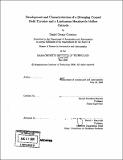Development and characterization of a diverging cusped field thruster and a lanthanum hexaboride hollow cathode
Author(s)
Courtney, Daniel George
DownloadFull printable version (52.11Mb)
Other Contributors
Massachusetts Institute of Technology. Dept. of Aeronautics and Astronautics.
Advisor
Manuel Martínez-Sánchez.
Terms of use
Metadata
Show full item recordAbstract
A low power, magnetically confined plasma thruster has been developed and undergone preliminary characterization. The design employs cusped magnetic fields arranged in a divergent fashion to confine electron flow to an anode while providing efficient acceleration of an ion beam, similar to traditional Hall type thrusters. The design, referred to as a Diverging Cusped Field (DCF) thruster, employs aspects of both existing cusped field thrusters and traditional Hall thrusters while including several unique design features aimed at increasing performance. In addition to supporting competitive thrust and efficiency performance, the DCF magnetic arrangement confines the discharge plasma away from the channel walls in order to reduce wall erosion and promote long lifetimes. The thruster has demonstrated performance levels comparable to typical commercial Hall thrusters. Specifically, a nominal anode efficiency of 44.5% has been achieved while providing 13.4mN of thrust at xenon mass flow rate of 8.5sccm and consuming 242W of anode power. The corresponding nominal specific impulse was 1640s. Preliminary observations suggest that the arrangement successfully contains the plasma away from the channel walls throughout the majority of the discharge chamber. Unique aspects of the DCF discharge include an apparent bi-modal operating spectrum and an irregular beam profile. While efficient operation has been observed in both operating modes, the transitions are shown to be accompanied by variations in both ionization efficiency and ion energy distribution. The emitted plume was observed to be conical in shape, with a hollow interior and concentrated ion flux diverging at roughly 32°. In addition to the DCF thruster, a small lanthanum hexaboride (LaB6) hollow cathode has been developed for use with plasma thrusters within the MIT Space Propulsion Laboratory. Lanthanum hexaboride was selected due to its insensitivity to impurity poisoning and resultant suitability for experiments which require frequent exposure to atmospheric conditions. The cathode was designed based on larger LaB6 cathodes developed at NASA JPL. Significant alterations to the design included a threaded ceramic heater and the inclusion of a thin radiation shield between the cathode tube and keeper electrode. Total current levels between 0.75A and 2.5A were sustained with the external heater deactivated after an initial ignition procedure. Typically the insert had reached temperatures suitable for emission after roughly 30 minutes of external heating at up to 110W of heater power.
Description
Thesis (S.M.)--Massachusetts Institute of Technology, Dept. of Aeronautics and Astronautics, 2008. MIT Aero Library copy: printed in pages. Includes bibliographical references (leaves 147-152).
Date issued
2008Department
Massachusetts Institute of Technology. Department of Aeronautics and AstronauticsPublisher
Massachusetts Institute of Technology
Keywords
Aeronautics and Astronautics.